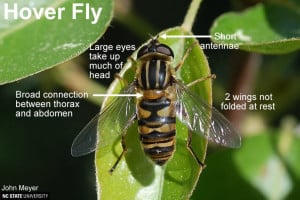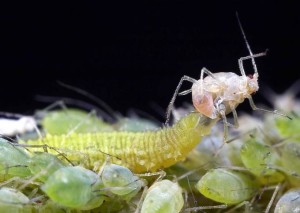
Meet the hoverfly
Hoverflies are tremendous beneficial predators to attract into your landscape, as their larvae are voracious aphid-eating machines. They resemble a cross between a fly and a small yellow jacket at first glance. Besides their favorite snack, aphids, they provide excellent control ofscale, thrips, tiny mites and small caterpillars, like the cabbageworms that devour your broccoli and cruciferous vegetables.
While they may occasionally land on people, don’t worry because they don’t sting or bite. They’re just attracted to your salty sweat, a small offering for their hard work.
How to Attract Hoverflies
Try planting some of these easy-to-grow flowers and herbs for attracting hoverflies
- Common Chives (Allium schoenoprasum)
- Alyssum ‘Carpet of Snow’
- Thyme
- Parsley
- Lavender
- Marigolds
- Dill ‘Mammoth’
- Cosmos.

Hoverfly larva eating an aphid
These plants are also favorites of other beneficials, like bees and parasitic mini wasps.
Learn to tolerate small outbreaks of aphids and other pests if you see hoverflies around your garden beds. With a little patience, the female hoverfly will lay scattered eggs on leaves being fed upon by small plant-sucking insects. Upon hatching, the hoverfly larvae feed on these pests for several weeks before pupating into adults.
Adult hoverflies feed primarily on the nectar of flowers and also help to pollinate.
With a couple of generations possible per year, you’ll soon begin to see your pest pressures diminish.
Try planting alyssum near your roses if you have had problems with curled rose slugs (sawfly) in the past.
GET THE LATEST NEWS
Subscribe to the Organic Plant Care Newsletter and get timely and helpful tips and updates monthly.
There's no spam - we promise!





